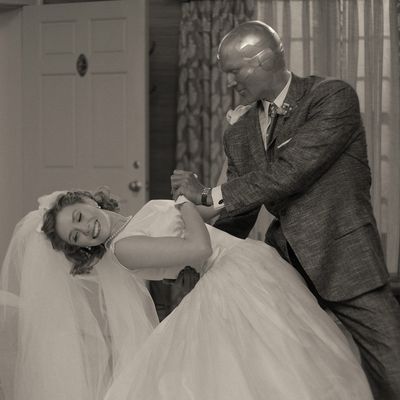
In the first episode of WandaVision, extremely normal suburban ’50s housewife Wanda Maximoff asks her extremely normal suburban ’50s husband, Vision, what he would say to a hearty breakfast.
“I’d say, ‘Oh, I don’t eat food,’” Vision replies, as an unseen audience laughs.
“That explains the empty refrigerator,” Wanda says cheerily, opening the icebox to reveal shelves devoid of food and drink.
Obviously Wanda (Elizabeth Olsen) and Vision (Paul Bettany) are not, uh, normal. Both are characters from the Marvel Cinematic Universe. As those films and the comics that preceded them have explained, Wanda, also known as the Scarlet Witch, is a woman with extraordinary telekinetic powers, while Vision is an android with a vibranium body. (Hence the not eating.)
We last saw this odd couple in Avengers: Infinity War. In the Disney+ series WandaVision, they bounce through multiple riffs on classic American sitcoms, each set in a different decade, playing slightly different versions of a married pair while attempting to keep their uniqueness hidden from their (naturally) nosy neighbors. But with every passing episode, a mysterious Marvel-verse reality begins to bleed into the frame — suggesting there’s something happening in this narrative beyond the fun, retro flashbacks.
That clever premise puts WandaVision in several categories at once: a comedy and a mystery, a superhero story and a period-piece spoof. It’s Pleasantville. It’s a Marvel movie. It’s very much a TV show. And, somehow, it all works. Series creator and head writer Jac Schaeffer and director Matt Shakman, who handles all nine episodes (three of which were provided for review), gear shift between tones and genres without seeming like they ever need to tap the clutch.
This is the first Marvel series to debut on Disney+, and it’s been designed, in Disney tradition, as a piece of entertainment customizable to all interests. If you’re an MCU obsessive who knows all of the mythology inside out and upside down, you may find your retinas screwed to the screen, searching for Easter eggs that explain what’s happening to Wanda. If you have somehow skated through life without seeing a single Avengers film, you can still find delight in the riffs on The Dick Van Dyke Show, The Brady Bunch, and others, as well as the big kick that Olsen and Bettany seem to be getting from putting a superpowered spin on sitcom tropes. Like the Marvel movies, each episode can stand on its own, but together they’re playing a broader sci-fi game.
The first episode drops the just-married Wanda and Vision into a traditional 1950s comedy, complete with black-and-white imagery, a 4:3 aspect ratio, and a plotline involving misunderstandings about hosting Vision’s boss for dinner. The episode was even shot in front of a live studio audience for maximum ’50s effect, their laughs juicing every gag.
Episode two moves to the 1960s, complete with opening titles reminiscent of Bewitched, while episode three accelerates into the early 1970s and onto a set nearly identical to the one where the Bradys bunched, down to the sunken living room and stained-glass windows. The entire creative team — production designers, costumers, cinematographers — did meticulous work replicating the details in each of these suburban dreams, from the women’s Jackie O. flip-dos in the ’60s, to lighting choices that lend each episode an era-appropriate patina. WandaVision even weaves in funny retro commercials, complete with references to familiar Marvel characters and entities.
Olsen and Bettany’s characters were often treated like benchwarmers on an all-star team in the Avengers movies. Here, they really shine. Both actors are known primarily for their dramatic work, in and outside of the MCU, so it’s a treat to watch them leap uninhibited into broad comedy. Olsen’s numerous Wandas veer from dotty to unsure to determined, and especially in the ’50s and ’60s episodes, she carries every changeup with the grace of a game-show hostess showing off a brand-new Chrysler. With his lanky, six-foot-plus frame, Bettany slides easily into the role of the devoted, kinda square, goofball husband. His physical comedy skills are especially strong in episode two, when Vision stumbles, slurs, and mugs his way through a magic show. That performance, in particular, confirms he’s got the chops of both a Dick Van Dyke and a member of Monty Python.
The two leads are surrounded by a strong cast that includes Kathryn Hahn as Agnes, the neighbor who’s up in everyone’s business and delivers her lines as if they’re sliding out the side of her mouth. She’s perfect. Teyonah Parris enters the picture in episode two as a neighbor named Geraldine, who immediately bonds with Wanda for reasons that I won’t spoil here.
The notion of revealing one’s true self is a running theme throughout the series. Wanda and Vision, both outcasts of a sort within the Avengers world, also feel like misfits in every seemingly pristine suburbia they encounter. Both want very much to be accepted, and both know that means keeping their true natures — Vision’s non-humanity, Wanda’s ability to conjure the unimaginable — hidden. It becomes increasingly clear that the choice to place the series within a sitcom construct isn’t just a lark: It suggests Wanda may be trying very hard to escape reality. It ends up acting as a commentary on social expectations, too.
If Wanda and Vision can blend into each new community and keep their unusual gifts hidden, they’ll be safe and okay at the end of every half hour. But as ominous signs begin to creep into their blissful, lawn-mown bubble, WandaVision is already signaling — with grand ambition, infectious energy, and moments of intriguing suspense — that these time-traveling characters can only play house for so long.
(If you subscribe to a service through our links, Vulture may earn an affiliate commission.)


